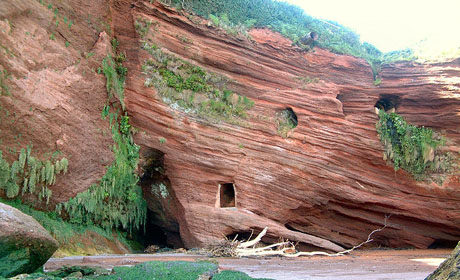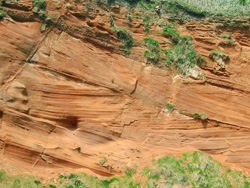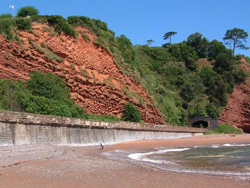Dawlish, Devon, England

These colourful outcrops along the Dawlish Coast, easily visible from the train, provide a reminder of when Britain lay closer to the equator and much of the country as we now know it was a desert! A stunning exposure of the New Red Sandstone, easily accessible by public transport and the South West Coast Path, the cliffs are formed from aeolian (wind-blown) sand which was laid down in a desert in a continental interior in the Permian Period roughly 250 million years ago.
 The cliffs began as windblown, oxidized red desert sands laid down as dunes: many of the exposures show beautiful dune cross bedding. Interbedded with the dune sandstones are beds of angular pebbles laid down by repeated flash floods during wetter periods.
The cliffs began as windblown, oxidized red desert sands laid down as dunes: many of the exposures show beautiful dune cross bedding. Interbedded with the dune sandstones are beds of angular pebbles laid down by repeated flash floods during wetter periods.
Dawlish Cliffs are an essential site for understanding the processes through which aeolian sediments are laid down. Normally deposits in cliffs like those at Dawlish represent sediment deposition over thousands of years but here, in the very dynamic desert environment of the Permian, the cliff deposits may have been deposited within a few tens or hundreds of years.
Exploring the Cliffs
Walking south to north, starting at Coryton’s cove at the southern end of Dawlish's coast, Coryton Breccia (of many clast types including quartzite and pink feldspars) and Teignmouth Breccia (including Devonian and Carboniferous slates, cherts, and igneous rocks) can be seen there. These were laid down in an alluvial fan. A major fault at Coryton’s Cove brings these and the overlying Dawlish Sandstone together.

North of the railway station you can see the sandstone cliffs by walking along the sea wall – there are railway lines between the sea wall and the cliffs so examination with a hand lens is not possible! One word of warning: The tide reaches right to the sea wall and in stormy conditions the waves can crash over it making access very dangerous.
The cliffs show large-scale cross-bedding, especially near Black Bridge. The preserved stratification of these dune sands shows that they were migrating eastwards. Easily visible in the cliffs is clear evidence of flash flooding, stream beds filled with larger clasts. Wind-blown sands have then again been deposited above these ephemeral streams. These were laid down horizontally but have become tilted along with the rest of the cliffs.
As the railway line turns north to Dawlish Warren, Langstone Rock displays the Exe Breccia, coarse sediments emplaced in an alluvial fan. Langstone Rock is in fact the type section for this formation. It may well be that the change from the wind-lain Dawlish Sandstone Formation to the water-lain Exe Breccia, which lies above it in stratigraphic terms, is evidence of climate change as rainfall increased at the end of the Lower Permian.
A natural arch is visible from the north side and also seen from here the start of the Jurassic Coast on the west side of the Exe presents opportunities for further exploration.
Text: Naomi Stevenson (Green Geology) and Howard Colley